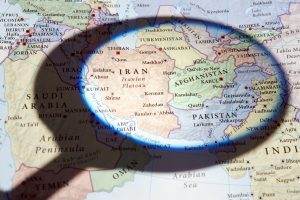A high-ranking Iranian economic delegation, including lawmakers and private investors, led by Industry, Mining, and Trade Minister Seyed Mohammad Atabak, visited Afghanistan for three days from September 15 to 17 to hold high-level talks with the Taliban regime. The objective of these discussions was to enhance investment and trade between the two countries.
A spokesman for the Taliban Ministry of Industry and Commerce, Abdul Salam Jawad Akhundzada, said that the Iranian delegation’s visit “aims to identify obstacles hindering bilateral trade and to improve cooperation in transport and joint investment.”
During the visit, the Iranian delegation also met with officials from the prime minister’s economic office, as well as representatives from the ministries of mines and petroleum, and public works, along with members of the Afghan private sector. In addition, the delegation visited Afghanistan’s western province of Herat in order to inspect mines, the railway, and the Islam Qala border crossing.
Besides exploring new investment opportunities, the visit sought to expand Afghanistan-Iran bilateral trade with the goal of increasing it to $10 billion from the current $3.5 billion. It is yet to be determined whether the targeted increase in trade would benefit Afghanistan, mainly the common Afghan, or not; Iran already holds a trade surplus in the bilateral relationship.
Iran’s Atabak, nevertheless, seemed positive about his country’s commitment to cooperate with Afghanistan. He emphasized Iran’s intention to strengthen trade relations with all of Iran’s neighboring countries, particularly Afghanistan. He highlighted the historic ties between the two nations and reaffirmed Iran’s commitment to enhancing commercial and economic cooperation with Afghanistan. “We intend to pursue the plans we have laid out during our meetings with Afghan government officials to elevate the level of exchanges and strengthen bilateral cooperation, and to initiate new programs as well,” Atabak said.
According to the Tehran Times, the bilateral discussions also covered joint work in the mining sector, banking ties, expansion of cargo movement via the Khaf-Herat railway, and the greater use of Iran’s Chabahar port, which is currently being developed by India as part of a 10-year agreement. During an economic and trade meeting between delegations from both sides, Iran’s delegation proposed to adjust shipping capacities of the Chabahar port to accommodate more vessels with 50-container capacities to smoothly streamline the port operations.
The Chabahar port is significant for Afghanistan as it can provide the landlocked country a new sea route to international markets as an alternative to the traditional routes through Pakistan’s Karachi and Gwadar ports. In May 2025, China, Pakistan, and Afghanistan agreed to connect Afghanistan to China’s Belt and Road through the China-Pakistan Economic Corridor (CPEC) during their foreign ministers’ meeting in China. If the Taliban regime successfully manages to gain access to international markets on both sides of Afghanistan’s borders, they will be in a solid position to defy the sanctions imposed by the U.S.-led West and to end their international isolation.
Growing ties with Iran hold special importance for the Taliban. Iran opposed the Taliban during its first stint in power from 1996 to 2001 and supported the anti-Taliban Northern Alliance. Tehran’s influence in Afghanistan had increased during the Karzai and Ghani administrations; with the Taliban’s takeover of Kabul in August 2021, Iran’s influence in the country diminished.
The Taliban’s return rise to power caused alarm in the Iranian government, stoking concerns about an anti-Shia extremist group gaining control in its neighborhood once again. However, political pragmatism dictated that Tehran engage with the Taliban. Thus, Iran chose to interact with the Taliban without officially recognizing the regime as Afghanistan’s legitimate government. Iran has maintained an active diplomatic presence in Afghanistan during the last four years.
Since then, despite some outstanding issues, relations between the two have been moving on a somewhat positive trajectory. Iran’s Foreign Minister Abbas Araghchi’s visit to Afghanistan in January 2025, making him the first top diplomat from Iran to visit Afghanistan after almost a decade, signaled a new phase for relations. During his visit, he held meetings with his Taliban counterpart, Amir Khan Muttaqi, and Prime Minister Hassan Akhund. The two sides discussed bilateral issues including water resources and migration.
The issue of water resources associated with the Helmand River has been a bone of contention between the two countries since the 1870s. Since the Taliban regained power, tensions over the river, despite a 1973 treaty, have intensified. In May 2023, clashes between border guards from both countries resulted in the deaths of two Iranian border guards and one Taliban soldier, along with injuring several others on both sides. A few days before the May 2023 clashes, the Taliban maintained that, due to water scarcity, Afghanistan could not meet Iran’s water demands.
In addition to the water resources issues, there is also the issue of Afghan migrants in Iran. According to the United Nations Refugee Agency (UNHCR), approximately 3 million Afghan refugees live in Iran. Of these, 750,000 are officially registered refugees, and around 500,000 hold short-term residency permits or restricted work permits. Many of these migrants moved to Iran during the Soviet invasion of Afghanistan. However, others arrived after the Taliban established its current regime in 2021. Since the beginning of this year, Iran has begun mass deportations of these refugees back to Afghanistan. The situation has exacerbated the crisis in Taliban-led Afghanistan as it is ill-equipped to handle such a large influx of people amid its existing multifaceted humanitarian crises.
Despite these challenges, the Iranian delegation’s visit to Afghanistan indicates a growing relationship between the Taliban regime and Iran. With both sides facing international sanctions, they cannot afford to remain antagonistic, especially considering their geographical proximity. It is yet to be seen what impact the Iranian delegation’s visit will have on the resolution of bilateral issues and trade and investment in Afghanistan. Without settling their issues, mainly over water resources, the ties cannot improve, which can also dent trade and future investments.




























